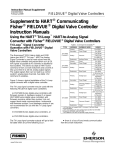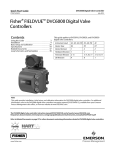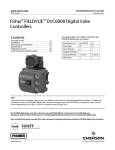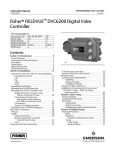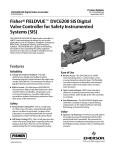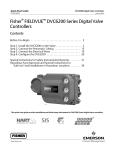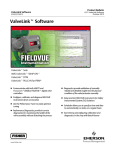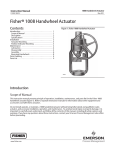Download Emerson FIELDVUEDVC2000 Instruction Manual
Transcript
Instruction Manual Supplement DVC6000/DVC6200 Digital Valve Controllers D103261X012 February 2011 Supplement to Fisherr FIELDVUEt DVC6000 or DVC6200 Digital Valve Controller Instruction Manuals Implementation of Lock‐in‐Last Strategy Many applications require a valve assembly to remain in the position it was prior to a specific control system failure (lock‐in‐last position). Functionality and safety can be designed into valve assemblies with FIELDVUE digital valve controllers by utilizing an array of accessories. The following paragraphs describe standard solutions for a number of generic lock‐in‐last applications with DVC6000 or DVC6200 digital valve controllers. Note This instruction manual supplement is for use with HARTr communicating FIELDVUE DVC6000 or DVC6200 digital valve controllers only. Lock‐in‐Last on Loss of Supply Pressure Once the supply pressure falls below a minimum value, the digital valve controller can no longer position a valve assembly; the valve will start to go to the actuator “at rest” position. The locking device senses this change and activates, preventing the remaining air from venting. The valve is “locked‐in” this new position. Note The locked‐in valve position depends on the exhausting speed of the actuator. Assemblies with Single‐Acting Actuators A Fisher 164A three‐way switching valve should be used for locking a single‐acting actuator in place on loss of supply pressure. Figure 1 is a schematic representing proper assembly layout. In normal operation, the digital valve controller output passes through the switching valve from port A to port B and on to the actuator. www.Fisher.com Instruction Manual Supplement DVC6000/DVC6200 Digital Valve Controllers February 2011 D103261X012 Figure 1. Lock‐in‐Last on Loss of Supply Pressure for an Assembly with a Single‐Acting Actuator (Fisher DVC6000 Depicted) FISHER 164A THREE‐WAY SWITCHING VALVE D A B C DIGITAL VALVE AIR SUPPLY OUTPUT SUPPLY CONTROLLER FISHER 67CFR FILTER/REGULATOR In a fail condition, the pressure at port D is below the switching valve's set point, causing the switching valve to trip. This closes port B, which locks the pressure in the actuator. Port C is plugged so the digital valve controller output will not exhaust to the atmosphere. Assemblies with Double‐Acting Actuators Similar to the locking strategy used with single‐acting actuators, the locking strategy with double‐acting actuators also uses a valve for locking supply pressure in the actuator. For assemblies with double‐acting actuators, a Fisher 377L trip valve is used as the locking device. The 377L trip valve has two output ports for locking pressure on both sides of a double‐acting actuator. Figure 2 is a schematic representing proper assembly layout. Figure 2. Lock‐in‐Last on Loss of Supply Pressure for an Assembly with a Double‐Acting Actuator (Fisher DVC6000 Depicted) FISHER 377L TRIP VALVE INPUT DA E B F C FISHER 64 REGULATOR DIGITAL VALVE CONTROLLER 2 OUTPUT SUPPLY OUTPUT AIR SUPPLY Instruction Manual Supplement D103261X012 DVC6000/DVC6200 Digital Valve Controllers February 2011 Connection of the digital valve controller output to a double‐acting actuator determines the action of the actuator. Figure 2 shows the digital valve controller providing lower cylinder pressure through ports D and E, and upper cylinder pressure through ports A and B. When the supply pressure falls below the set point of the trip valve, the trip valve closes ports D and A and connects port B to C and port E to F. Because C and F are plugged, the control valve is locked in place by locking pressure on both sides of the actuator piston. The assembly returns to normal operation once supply pressure is restored at the trip valve INPUT port. Note Double‐acting actuators with a 377L trip valve require a Fisher 64 or 95H regulator. Regulators with smaller flow capacities may cause the trip valve to cycle (lock and unlock repeatedly) due to air flow demand as the assembly attempts to reset. Use a Fisher 252 or 262C pilot filter to filter supply air. Both the 164A switching valve and the 377L trip valve have a deadband that must be overcome. The switching valve must be calibrated to reset upon restoration of adequate supply pressure to the regulator. The 377L trip valve has only one spring selection. However, for minimal deadband, the lightest appropriate spring should be selected for the 164A switching valve. Lock‐in‐Last Using Solenoid Valves Solenoid valves are used with valve assemblies in many ways. Their electrical control can be utilized in combination with switches and controller logic to perform a number of functions. Note Solenoid valves placed between the output of a DVC6000 or DVC6200 digital valve controller and the input to an actuator require a minimum Cv of 0.49. Greater restrictions can affect the response of the assembly. An example of an appropriate three‐way solenoid valve for use with the digital valve controller is the ASCO™ 8327 Series solenoid valve from ASCO Valve, Inc. Assemblies with Single‐Acting Actuators A three‐way universal solenoid valve can be placed between the digital valve controller output and the actuator input. Switching the valve assembly from an unlocked state to a locked state is controlled by switching power on and off to the solenoid valve. Figure 3 depicts proper assembly layout. Under normal operating conditions the solenoid is energized and supply air flows from the digital valve controller output to the actuator input. In the fail state, power is removed from the solenoid causing the solenoid valve to close, locking air pressure in the actuator. Port 1 of the solenoid valve is plugged, preventing actuator air pressure from exhausting to the atmosphere. 3 Instruction Manual Supplement DVC6000/DVC6200 Digital Valve Controllers February 2011 D103261X012 Figure 3. Lock‐in‐Last Strategy for an Assembly with a Single‐Acting Actuator Using a Solenoid Valve (Fisher DVC6000 Depicted) SOLENOID VALVE (ENERGIZED) 2 1 24 VDC POWER SUPPLY 3 1 FISHER 67CFR FILTER/REGULATOR DIGITAL VALVE OUTPUT SUPPLY AIR SUPPLY CONTROLLER NOTE: 1 A SOLENOID VALVE WITH A MINIMUM CV OF 0.49, SUCH AS THE ASCO 8327 SERIES OR EQUIVALENT, IS REQUIRED FOR THIS ASSEMBLY Assemblies with Double‐Acting Actuators Assemblies with double‐acting actuators require a 377L trip valve to lock pressures on both sides of the actuator piston. Figure 4 is a schematic of a double‐acting actuator with lock‐in‐last capability shown in its normal operating mode. The solenoid valve is placed in series with the signal port of the trip valve. When tripped, the solenoid valve exhausts the signal pressure to the trip valve to atmosphere. This simulates a loss in supply pressure, causing the trip valve to lock pressure in the actuator. Figure 4. Lock‐in‐Last for an Assembly with a Double‐Acting Actuator Using a Solenoid Valve (Fisher DVC6000 Depicted) SOLENOID VALVE (ENERGIZED) FISHER 377L TRIP VALVE D A E B F C 1 1 24 VDC POWER SUPPLY 2 3 FISHER 64 REGULATOR DIGITAL VALVE CONTROLLER OUTPUT SUPPLY OUTPUT AIR SUPPLY FISHER 252 AIR/GAS FILTER NOTE: THE ASCO 8320 SERIES SOLENOID VALVE OR EQUIVALENT IS APPROPRIATE FOR THIS ASSEMBLY. 1 4 Instruction Manual Supplement DVC6000/DVC6200 Digital Valve Controllers D103261X012 February 2011 The solenoid valve in this solution does not require a Cv greater than 0.49. Flow capacity of this valve can be much smaller. An example of a proper solenoid valve for this assembly is the 8320 Series three‐way solenoid valve. As with all solenoid valves, ensure that the solenoid valve operating pressure differential rating is adequate for the supply pressure. Lock‐in‐Last on Loss of Supply Pressure and/or Loss of Loop Current Most applications require a valve assembly to be in a lock‐in‐last fail state not only on loss of adequate supply pressure but also on loss of loop power. Lock‐in‐last on loss of supply pressure is quite straight forward. Lock‐in‐last on loss of loop power can be more complex. Most control loops operate on a 4‐20 mA control signal. A solenoid valve, adequately sized for the application, requires more than 4 mA to energize. Therefore, the control loop cannot be used to energize the solenoid. Instead the solenoid must be powered by a separate 24 volt power source. Thus an additional device is required to monitor the current to the digital valve controller and control the power to the solenoid. A current threshold switch can be used to monitor the 4‐20 mA signal to the digital valve controller. Upon loss of this signal, or when the signal falls below the threshold, the threshold switch will open an internal relay. This relay, if placed between a solenoid valve and its power supply, will essentially open and close the solenoid valve. The solenoid valve can be placed in line with the tubing to the actuator to provide the lock‐in‐last function. To ensure adequate response time of a locking system to a loss of loop current, a threshold switch with a maximum deadtime of 0.025 seconds should be used. The locking system will be faster than the response of the positioning system to the failure. One switch that meets the maximum deadtime requirements is the Phoenix Contact Dual Setpoint Module, Model MCR‐2SP/UI. Note The MCR‐2SP/UI switch is not provided by Emerson Process Management. Order this switch from Phoenix Contact. Assemblies with Single‐Acting Actuators Assemblies with a single‐acting actuator use a 164A three‐way switching valve in conjunction with a solenoid valve. Figure 5 is a schematic of a single‐acting actuator assembly with lock‐in‐last capability on loss of supply pressure or loop current. Under normal operating conditions power is supplied to the solenoid valve and adequate supply pressure is available to the switching valve. Upon loss of supply pressure, the set point of the switching valve is exceeded and the switching valve trips. 5 Instruction Manual Supplement DVC6000/DVC6200 Digital Valve Controllers February 2011 D103261X012 Figure 5. Lock‐in‐Last on Loss of Loop Current and/or Supply Pressure for an Assembly with a Single‐Acting Actuator (Fisher DVC6000 Depicted) FISHER 164A THREE‐WAY SWITCHING VALVE D B A C + FISHER 67CFR FILTER/REGULATOR DIGITAL OUTPUT SUPPLY VALVE CONTROLLER 1 4‐20 mA + - AIR SUPPLY SOLENOID VALVE (ENERGIZED) 1 PHOENIX 12 SWITCH MCR‐2SP/UI 13 2 1 2 7 8 3 + 24 VDC POWER SUPPLY + - NOTE: THE ASCO 8320 SERIES SOLENOID VALVE OR EQUIVALENT IS APPROPRIATE FOR THIS ASSEMBLY. 1 Upon loss of loop current, the relay of the current threshold switch opens. This cuts power to the solenoid valve, causing the solenoid valve to trip. When the solenoid valve trips, the supply pressure that was holding the switching valve open is exhausted to atmosphere. This simulates a loss of supply pressure, causing the switching valve to trip. Note Use a single power source for both the analog output (AO) card providing loop current to the digital valve controller and the solenoid valve. This ensures power will be maintained to the solenoid valve so long as power is maintained to the AO card. Assemblies with Double‐Acting Actuators The same principle used for assemblies with single‐acting actuators is used for assemblies with double‐acting actuators. Figure 6 is a schematic of the double‐acting assembly with lock‐in‐last capability shown under normal operating conditions. 6 Instruction Manual Supplement DVC6000/DVC6200 Digital Valve Controllers D103261X012 February 2011 Figure 6. Lock‐in‐Last on Loss of Loop Current and/or Supply ressure for an Assembly with a Double‐Acting Actuator (Fisher DVC6000 Depicted) + + 4‐20 mA 1 2 7 8 12 PHOENIX SWITCH MCR‐2SP/UI 13 FISHER 377L TRIP VALVE + SOLENOID VALVE (ENERGIZED) 1 DA EB 24VDC POWER SUPPLY 1 2 3 FC AIR SUPPLY FISHER 64 REGULATOR + DIGITAL VALVE CONTROLLER OUTPUT SUPPLY OUTPUT FISHER 252 AIR/GAS FILTER NOTE: THE ASCO 8320 SERIES SOLENOID VALVE OR EQUIVALENT IS APPROPRIATE FOR THIS ASSEMBLY. 1 Note DVC6000 and DVC6200 digital valve controllers require approximately 0.5 seconds to initialize upon power up. During this time, the digital valve controller cannot provide control. In the case where control of a previously locked valve is restored to a digital valve controller prior to the completion of initialization, the valve will travel toward its fail‐safe position. A relay with an engagement deadtime, such as the MCR‐2SP/UI from Phoenix Contact, can be used to delay the release of the locking system until the digital valve controller has completely initialized. An engagement delay of 1.0 seconds will adequately minimize the dip in travel. Note While the valve is in a locked state, the set point from the digital valve controller may change in response to changes in process conditions. This change in set point may result in a process bump when control is restored to the digital valve controller. Related Documents D Fisher FIELDVUE DVC6000 Digital Valve Controllers Instruction Manual (D102794X012) D Fisher FIELDVUE DVC6000 Digital Valve Controllers Quick Start Guide (D102762X012) D Fisher FIELDVUE DVC6200 Digital Valve Controller Instruction Manual (D103409X012) D Fisher FIELDVUE DVC6200 Digital Valve Controller Quick Start Guide (D103410X012) These documents are available from your Emerson Process Management sales office. Also visit our website at www.FIELDVUE.com. 7 Instruction Manual Supplement DVC6000/DVC6200 Digital Valve Controllers February 2011 D103261X012 Phoenix Threshold Switch Specifications(1) Switch Model Number MCR‐2SP/UI-DC Size 44.5 X 76.2 X 108 mm (1‐3/4 X 3 x 4‐1/4 inches) Mounting Mounts in control room (DIN rail mount) Wiring Connect switch in series between control loop and field device Control Loop + to switch terminal 2 Control Loop – to switch terminal 1 24 VDC Power Supply to switch connections Power Supply + to switch terminal 8 Power Supply - to switch terminal 7 Connect switch in series between the solenoid valve and 24 VDC power supply Power Supply + to switch terminal 12 Power Supply - to switch terminal 13 Configuration Set point 1: 15% (3 mA) Engagement Deadtime: 1 second Switch Settings Switch Setting Description 1 2 3 4 On On Off On SP 1 SP 2 In In 5 6 7 8 Off Off Off Off Out 1 Out 2 Hys. 1 Hys. 2 1. The Phoenix threshold switch is not supplied by Emerson Process Management. Order the switch from the manufacturer, Phoenix Contact (www.phoenixcontact.com). For complete installation details, see the instruction manual provided by the switch manufacturer. Note Neither Emerson, Emerson Process Management, nor any of their affiliated entities assumes responsibility for the selection, use, or maintenance of any product. Responsibility for the selection, use, and maintenance of any product remains with the purchaser and end user. Fisher and FIELDVUE are marks owned by one of the companies in the Emerson Process Management business division of Emerson Electric Co. Emerson Process Management, Emerson, and the Emerson logo are trademarks and service marks of Emerson Electric Co. HART is a mark owned by the HART Communication Foundation. All other marks are the property of their respective owners. The contents of this publication are presented for informational purposes only, and while every effort has been made to ensure their accuracy, they are not to be construed as warranties or guarantees, express or implied, regarding the products or services described herein or their use or applicability. All sales are governed by our terms and conditions, which are available upon request. We reserve the right to modify or improve the designs or specifications of such products at any time without notice. Neither Emerson, Emerson Process Management, nor any of their affiliated entities assumes responsibility for the selection, use or maintenance of any product. Responsibility for proper selection, use, and maintenance of any product remains solely with the purchaser and end user. Emerson Process Management Marshalltown, Iowa 50158 USA Sorocaba, 18087 Brazil Chatham, Kent ME4 4QZ UK Dubai, United Arab Emirates Singapore 128461 Singapore www.Fisher.com 8 EFisher Controls International LLC 2006, 2011; All Rights Reserved








